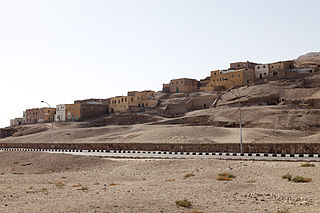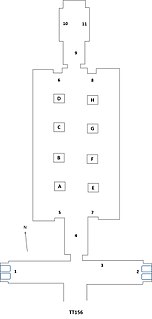
Ay was the penultimate pharaoh of ancient Egypt's 18th Dynasty. He held the throne of Egypt for a brief four-year period in the late 1300s BC. Prior to his rule, he was a close advisor to two, and perhaps three, other pharaohs of the dynasty. It is theorized that he was the power behind the throne during Tutankhamun's reign. Ay's prenomenKheperkheperure means "Everlasting are the Manifestations of Ra," while his nomenAy it-netjer reads as "Ay, Father of the God." Records and monuments that can be clearly attributed to Ay are rare, both because his reign was short and because his successor, Horemheb, instigated a campaign of damnatio memoriae against Ay and the other pharaohs associated with the unpopular Amarna Period.

The New Kingdom, also referred to as the Egyptian Empire, is the period in ancient Egyptian history between the sixteenth century BC and the eleventh century BC, covering the Eighteenth, Nineteenth, and Twentieth dynasties of Egypt. Radiocarbon dating places the exact beginning of the New Kingdom between 1570 BC and 1544 BC. The New Kingdom followed the Second Intermediate Period and was succeeded by the Third Intermediate Period. It was Egypt's most prosperous time and marked the peak of its power.

Heqamaatre Ramesses IV was the third pharaoh of the Twentieth Dynasty of the New Kingdom of Ancient Egypt. His name prior to assuming the crown was Amonhirkhopshef. He was the fifth son of Ramesses III and was appointed to the position of crown prince by the twenty-second year of his father's reign when all four of his elder brothers predeceased him. His promotion to crown prince:
is suggested by his appearance in a scene of the festival of Min at the Ramesses III temple at Karnak, which may have been completed by Year 22 [of his father's reign].

Amun-her-khepeshef was the firstborn son of Pharaoh Ramesses II and Queen Nefertari.

Ramesses was an ancient Egyptian crown prince during the 19th Dynasty.

Meryatum was an ancient Egyptian prince and High Priest of Re, the son of Pharaoh Ramesses II and Nefertari.

Qurnet Murai is a necropolis located on the West Bank of the Nile at Thebes, Egypt, just to the south of Sheikh Abd el-Qurna.
Amenmose, Amenmoses, Amenmesses or Amenmesse was an Egyptian name, found during the Late Bronze Age. Bearers of the name include:
Parennefer also called Wennefer was a High Priest of Amun during the reigns of Tutankhamun and Horemheb. He was previously thought to date to the time of Ramesses II, but he is now dated to the end of the Eighteenth Dynasty. Parennefer was more firmly put at the end of the Eighteenth Dynasty after extensive excavations of his tomb in Thebes in 1990–1993.

The Ancient Egyptian Noble Khay, (Kh-'-y) was Vizier, in the latter part of the reign of Ramesses II, during the 19th Dynasty.
Panehesy was a vizier of ancient Egypt. He served during the reign of Merenptah during the 19th Dynasty.

The Theban Tomb TT156 is located in Dra' Abu el-Naga', part of the Theban Necropolis, on the west bank of the Nile, opposite to Luxor. It is the burial place of the ancient Egyptian Pennesuttawy, who was a troop commander and superintendent of the Southern Desert Lands during the reign of Ramesses II in the Nineteenth Dynasty.
Pennesuttawy was a Military Commander and Superintendent of the Southern Lands (Kush) during the beginning of the Nineteenth Dynasty of Egypt.
The Theban Tomb TT170 is located in Sheikh Abd el-Qurna, part of the Theban Necropolis, on the west bank of the Nile, opposite to Luxor. It is the burial place of the ancient Egyptian Nebmehyt, who was a scribe of recruits of the Ramesseum in the Estate of Amun during the reign of Ramesses II in the Nineteenth Dynasty.

The Theban Tomb TT177 is located in El-Khokha, part of the Theban Necropolis, on the west bank of the Nile, opposite to Luxor.

The Nineteenth Dynasty of Egypt is classified as the second Dynasty of the Ancient Egyptian New Kingdom period, lasting from 1292 BC to 1189 BC. The 19th Dynasty and the 20th Dynasty furthermore together constitute an era known as the Ramesside period. This Dynasty was founded by Vizier Ramesses I, whom Pharaoh Horemheb chose as his successor to the throne.
The Theban Tomb TT282 is located in Dra' Abu el-Naga', part of the Theban Necropolis, on the west bank of the Nile, opposite to Luxor. It is the burial place of the ancient Egyptian Nakhtmin, also called Nakht, who lived during the reign of Ramesses II of the 19th Dynasty.
Hori was a High Priest of Anhur during the reign of Ramesses II. He was the son of the High Priest of Amun Parennefer called Wennefer and his wife Isis. He may be identical to the High priest of Amun mentioned on the statue of the Overseer of the Charioteers named Kanakht.
Nakhtmin was a Troop Commander of Kush and Royal Envoy to Every Foreign Land during the reign of Ramesses II.
This page is based on this
Wikipedia article Text is available under the
CC BY-SA 4.0 license; additional terms may apply.
Images, videos and audio are available under their respective licenses.










